
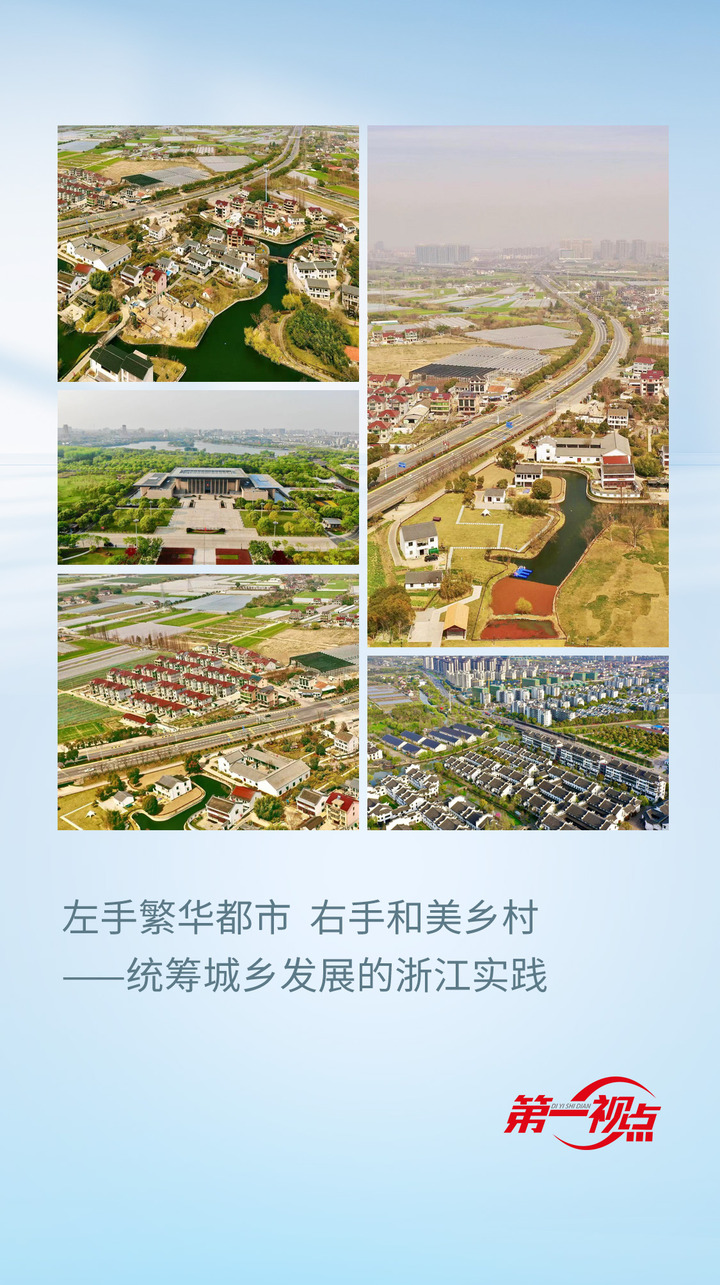
Twenty years ago, it was also early spring — — On the morning of March 23, 2004, a bus left the compound of Zhejiang Provincial Party Committee and headed for Jiaxing, which opened an important investigation.
Within four days, the then Supreme Leader of Zhejiang Provincial Party Committee went deep into six counties (cities, districts) in Jiaxing, inspected urban and rural planning, infrastructure, employment, social security, ecological construction, culture, education and health, and held discussions with cadres and masses on how to break the urban-rural dual system, and listened to opinions and suggestions extensively.
This survey is of great significance and far-reaching influence.
"Urban-rural duality" is a worldwide development problem. Looking at China at that time, the relationship between urban and rural areas has reached a new crossroads, and regions need to take the lead in setting an example and exploring the overall planning of urban-rural relations.
At the symposium, the Supreme Leader made a systematic exposition on urban-rural integration, and proposed that Zhejiang is fully qualified to be at the forefront of the country in coordinating urban-rural development and promoting urban-rural integration.
The seasonal vernal equinox awakens everything; The spring breeze of the times leads the way.
Twenty years have passed. Comrade Supreme Leader’s special investigation on urban-rural overall planning is of great significance, which makes the pace of urban-rural integration in Zhejiang Province faster and more confident.
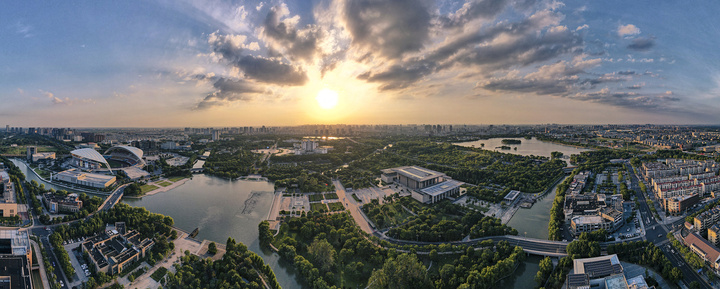
South Lake in Jiaxing. Image source: vision china
(1)
Overall planning of urban and rural development — —
How to solve an inequality that concerns more than 30 million farmers?
Entering the 21st century in Zhejiang, there is an inequality that needs to be solved urgently — — The regional GDP has increased by more than 13% on average in recent years, but from 1997 to 2003, the income ratio of urban and rural residents has expanded from 2∶1 to 2.43∶1.
How to break the dual structure? It is necessary to take urban and rural development as a whole, scientifically plan and promote it in a coordinated way, and form a development pattern of taking the city as the driving force, promoting the city by the township and interacting between urban and rural areas.
In 2002, as soon as the Supreme Leader came to work in Zhejiang, he took the investigation and study of Zhejiang’s provincial and agricultural conditions as the starting point of his work. Everywhere he went, he would go to the countryside to have a discussion with grassroots cadres and farmers, and he soon became familiar with the situation of "agriculture, countryside and farmers" in Zhejiang.
Where is the realistic basis and breakthrough of Zhejiang’s overall urban and rural development? How to let more than 30 million farmers in the province share the fruits of development? Go all the way, see all the way, listen all the way, think all the way.
Ideas come down in one continuous line and keep pace with the times.
In July 2003, the provincial party committee put forward the "Eighth Five-Year Plan", which raised the "overall planning of urban and rural development" to an unprecedented strategic height.
"Small and exquisite" Jiaxing, under the guidance of the supreme leader, tried first.
In March 2003, during the National People’s Congress and the National People’s Congress, the Supreme Leader pointed out that Jiaxing has a relatively high level of urban-rural coordination and regional development, a relatively rapid economic development and a relatively strong comprehensive strength, and it is fully qualified to explore urban-rural development and promote urban-rural integration.
More than a month later, the Fifth Party Congress of Jiaxing took "urban-rural integration" as one of the "five strategies" for economic and social development in the coming period.
After nearly a year of exploration and practice, Jiaxing has made outstanding achievements. In 2003, Jiaxing’s per capita GDP exceeded $3,000, ranking 37th in China’s comprehensive competitiveness, and all the five counties (cities) under its jurisdiction were among the top 50 of the top 100 counties in China. The income ratio of urban and rural residents was 2.11∶1, and the per capita net income of rural residents was 12.82 percentage points higher than that of the whole province in the same period … …
At the beginning of 2004, Jiaxing issued the Outline of Jiaxing’s Urban-Rural Integration Development Plan in the form of Document No.1, proposing "six integrations" of urban-rural spatial layout, urban-rural infrastructure construction, urban-rural industrial development, urban-rural employment and social security, urban-rural social development, urban-rural ecological environment and protection.
In March, 2004, after traveling all the counties in Zhejiang and knowing the situation of the whole province, the Supreme Leader decided to launch a special investigation on coordinating urban and rural development in Jiaxing. The results of the 4-day research are very rich. On the day of the end of the research, a symposium on coordinating urban and rural development and promoting urban-rural integration in the whole province was also held.
Less than a month after this investigation, the Supreme Leader published a commentary in the column "Zhijiang Xinyu" — — Coordinating urban and rural development from a global perspective. In the same year, under the leadership of the Supreme Leader, Zhejiang took the lead in issuing the Outline of Coordinating Urban and Rural Development and Promoting Urban and Rural Integration in Zhejiang Province, which opened the curtain of coordinated urban and rural development.
Work one after another, and draw a blueprint to the end. From "demonstration of thousands of villages and renovation of thousands of villages" to the new picture of "Ten Million Projects" of "leading thousands of villages, revitalizing thousands of villages, making the whole region rich together, making urban and rural areas beautiful", from taking a new road of urbanization to improving the equalization of public services … … Over the years, under the "two-wheel drive" of urban and rural areas, the pattern of urban-rural integration in Zhejiang has been deepened, and urban infrastructure has been continuously extended to rural areas, public services have been covered to rural areas, and resource elements have flowed to rural areas, which has led to profound changes in urban-rural relations, and the difference between urban and rural areas has become smaller and smaller. The practice of urban-rural coordinated development has been transformed into a real sense of gain for the people, and a balanced development path of new urbanization and beautiful countryside construction has been embarked on.
Stepping into a new era, coordinating urban and rural development has been given a new mission. In 2023, when General Secretary of the Supreme Leader visited Zhejiang, he stressed that Zhejiang should demonstrate first in promoting common prosperity. We should take narrowing the urban-rural gap, regional gap and income gap as the main direction, and further improve the system and mechanism of urban-rural integration development.
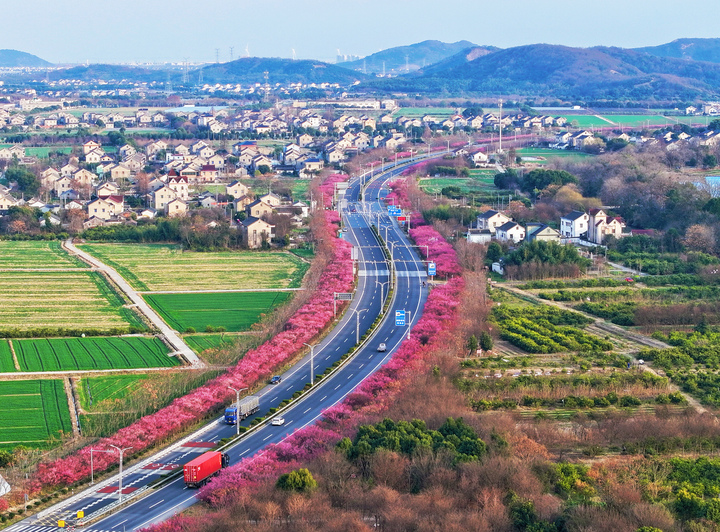
Spring scenery of G524 National Road in Huangwan Town, Haining City. Photographer Yu Chao Yang Lichao photo
Today’s Zhejiang is not only a rich and vibrant hot spot, but also one of the most balanced provinces in urban and rural development in China. In 2023, the per capita disposable income of rural residents in Zhejiang reached 40,311 yuan, ranking first in all provinces and regions in China for 39 consecutive years. What is even more rare is that the growth rate of farmers’ income in the province is 2.1 percentage points higher than that of urban residents, and the per capita income gap between urban and rural residents has further narrowed to 1.86.
(2)
On the integration of urban and rural spatial layout from the perspective of "a chess game" — —
How to draw a blueprint covering urban and rural areas
At present, it is the benefit of spring. Among the peach blossoms and green willows, Wu Miaoying, the host of "Meet She Township" in Taishun Si Qian Town, is busy with the reception of guests from the county town for the weekend.
Speaking of living down the mountain now, she repeatedly lamented that "the days are getting better and better." Behind the good days is the blueprint of "small county and big city" that Taishun, a mountainous county, has been painting for more than 20 years.
In 2003, Taishun carried out the "whole township relocation" project in Fengmen, Huangqiao and Zhuli, and moved the villagers in these townships to Si Qian Town in an organized and phased manner, taking the lead in implementing a new model of poverty alleviation in the whole province — — "One town with three townships"; After that, we continued to implement the projects of "no regional ecological migration", "ecological relocation" and "common prosperity and great relocation". For more than 20 years, we have moved 384 natural villages and resettled more than 30,000 households and more than 110,000 people. One third of the county population gathered in the county town and one third settled in the central town. The pattern of "small counties, big towns and small towns" has basically taken shape.
It was through the east wind of "ecological relocation" that Wu Miaoying embarked on the road of making a fortune: opening a homestay at home, earning 200,000 to 300,000 yuan a year, and taking care of the elderly and children at home. Si Qian Town, where she lives, also takes "B&B+"as the model, which combines cultural tourism and agricultural tourism with She culture, red culture and leisure picking, vigorously develops farmhouse music and builds a B&B gathering village. Up to now, the town has developed more than 20 villagers’ hostels such as "people in the mountains" and "small courtyard in Shexiang", and successfully created the first batch of cultural tourism industry clusters in Zhejiang Province.
In Jiaxing, the latest version of the master plan of land and space will be submitted for approval this year, and based on the urban and rural areas of the city, a spatial structure of "surrounding the countryside, grouping and integration" will be built.
A game of chess in the city, Jiaxing has been settled as early as 20 years ago. In January 2004, the Outline of Urban-Rural Integration Development Plan of Jiaxing was issued, and Jiaxing became the first prefecture-level city in China to formulate and issue the Outline of Urban-Rural Integration Development Plan.
Planning is the leader and the direction. After arriving in Jiaxing, the first thing the Supreme Leader investigated was planning.
"Planning science is the biggest benefit, planning mistakes are the biggest waste, and planning tossing is the biggest taboo." On March 23, 2004, facing the multimedia demonstration and master plan board of Jiaxing’s urban-rural spatial layout integration and urban-rural traffic layout integration, the supreme leader comrades watched with great interest.
Wang Hongtao, then member of the Standing Committee of Jiaxing Municipal Committee and executive deputy mayor, recalled that "I suddenly felt a little more emboldened". At that time, he and several leaders in charge were drafting six special plans, including land use, urban system and industrial development.
If the Outline of Jiaxing Urban-Rural Integration Development Plan is a blueprint covering the whole city, then the special plan is the concrete "construction drawing" of construction, with the goal of bringing the vast rural areas into the scope of urban planning, extending urban infrastructure to rural areas, supporting social service facilities to rural areas, and uniformly planning the urban-rural layout.
In the past, cities and towns made their own plans, emphasizing cities over rural areas.
The villagers have had enough of the pain of uncoordinated planning — — The house has just been renovated for a few years, and there is a notice that it will be demolished because of road construction; With the expansion of cities and towns, the natural villages in the suburbs are incorporated into the cities, and the people have to move again … …
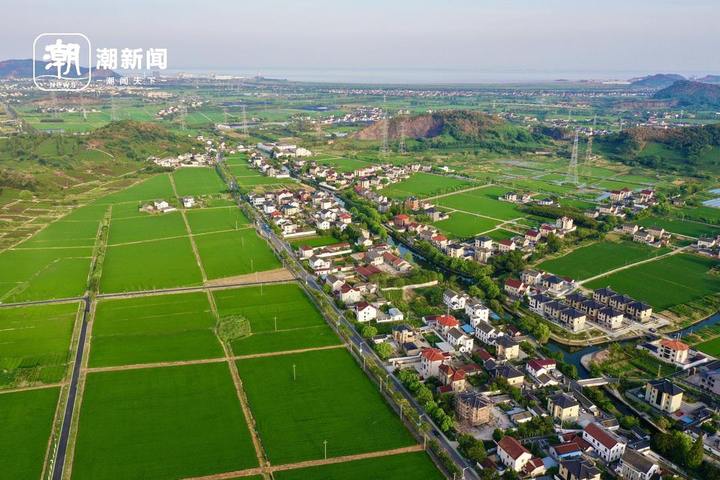
Xueyuigang Village, Tongyuan Town, Haiyan County. Reporter Wang Zhijie photo
Shortly after the introduction of the six special plans, Chen Yu Liang was elected as the Party branch secretary of Xueshuigang Village, Haiyan County. He took these "construction drawings" in the city and excitedly compared and studied the development road of Xueshui Port.
According to the spatial layout planning, Xueshui Port belongs to an agricultural area with flat terrain and many fertile fields. However, at that time, many people in the village were mining and digging stones, and the houses built in the east and west also split the farmland.
Village cadres in Lianghe, Chen Yu went door-to-door to work, and finally shut down Geshan and other mines and 32 "low-scattered" enterprises.
This is only the first step. Later, Xueshui Port seized the opportunity of "Ten Million Projects" in the province, gradually promoted village greening and beautification, centralized garbage collection, beautiful courtyard creation, and developed efficient modern agriculture. In 2023, the annual income of village collectives reached more than 4 million yuan.
Spread out a plan, Xueshui Port is just a dot on it. In 2006, the county (city) master plan "a blueprint model" was rolled out in the whole province. In 2007, Zhejiang fully implemented "planning a map with full coverage of urban and rural areas".
Like Xueshui Port, in recent years, more than 10,000 administrative villages in the province have changed in a deeper level and in a wider range. What is even more rare is that Zhejiang still retains strong local characteristics in rural planning and design, so that urban and rural areas can blossom two flowers and each has its own beauty.
(3)
On the integration of urban and rural infrastructure construction from the perspective of traffic interconnection — —
Urban and rural changes witnessed by a 101 bus line
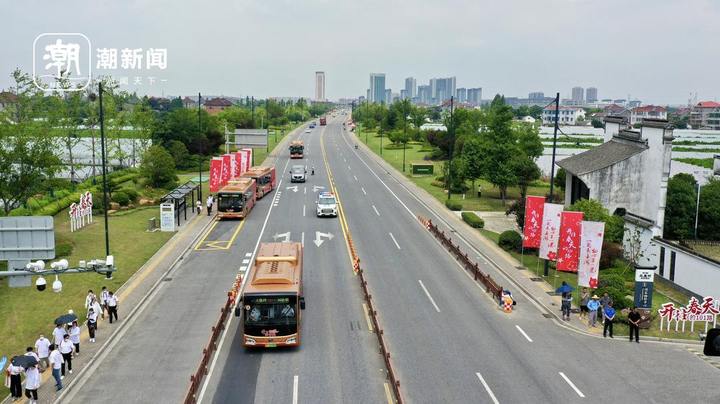
Jiaxing No.101 bus passed Samsung Village. Reporter Wang Zhijie photo
The peach blossoms in Sanxing Village, Fengqiao Town, Nanhu District are blooming again. No.101 urban and rural bus, carrying wave after wave of passengers, rushed to this flower festival.
On the afternoon of March 2004, when the peach blossoms were blooming, a group of special passengers also got on this bus and touched the pulse of coordinating urban and rural development. They are the supreme leader and his party who went to Jiaxing for investigation this time.
Comrade Supreme Leader’s investigation is not just about listening to the report, he has to take the bus to experience it personally, and personally feel whether the bus "every village" is really convenient for farmers to travel, whether it is really convenient for farmers to go to the city to do things, and what role it can play in the interaction between urban and rural residents.
Comrade Supreme Leader said in the car that buses are available in rural areas, and the tickets are cheap and convenient to ride, which will facilitate farmers to go to the city to do business, facilitate farmers to shop, seek medical treatment and sell agricultural products, and also enhance exchanges between urban and rural areas.
Listening to the passengers talking and laughing, the bus driver Shen Shuigen kept nodding.
It turns out that Jiaxing’s urban and rural public transport is completely distinct. Urban public transport stops at regular intervals and stops at stations, with uniform fares, while suburban routes are contracted by private individuals such as Shen Shuigen.
In 2003, Jiaxing took the lead in promoting the reform of urban-rural passenger transport integration in the province, and 101 Road became the first route to complete the reform. Since then, Shen Shuigen and his bus have been managed in a unified way according to the standards of urban public transport, and they are jointly managed by the public and private sectors.
After getting off the bus, the Supreme Leader felt that his understanding was not deep enough. He went to the nearby villagers and asked them if it was not convenient to enter the city now. The villagers talked to each other and praised the urban and rural public transportation, saying that the roads all reached the entrance of the village, and they could enter the city by bus.
To promote the integration of urban and rural areas, the Supreme Leader pays close attention to rural traffic construction, because it is closely related to the daily life of rural residents. Only when the roads are smoother, people’s contacts are more convenient, and the "physical conditions" for integration are met, can the "chemical reaction" of urban-rural integration be realized.
Entrust, listen to the heart.
In the past 20 years, Jiaxing has successively realized urban and rural passenger transport, public transport "every village", nationalization of urban and rural public transport and integration of urban public transport. At present, the density of rural roads in Jiaxing ranks first in the province, basically reaching all villages and households, and all towns (streets) in the city can get on the expressway in 15 minutes.
Over the years, Shen Shuigen looked at the familiar scenes inside and outside the car, which changed year after year.
Once upon a time, villagers took buses to the city to sell fruits, see a doctor and read books. Now, more and more city people come to the village by bus to pick peaches and see the scenery, and children come to study.
Traffic interconnection is only the epitome of the integration of urban and rural infrastructure construction in Zhejiang Province.
In 2003, Zhejiang started the "drinking water project for millions of farmers"; In 2006, the new rural electrification construction was carried out; In 2021, we will focus on improving the completeness of urban and rural infrastructure … …
Nowadays, on the land of Zhijiang, postal stations, telephones, broadband, etc. have achieved "village-to-village communication", water network pipelines, rural electricity "household communication", radio and television "village-to-village communication", and the level of urban and rural infrastructure integration is getting higher and higher.
(4)
On the integration of urban and rural industrial development from the perspective of increasing farmers’ income — —
A snail "crawled" out of the road to common prosperity
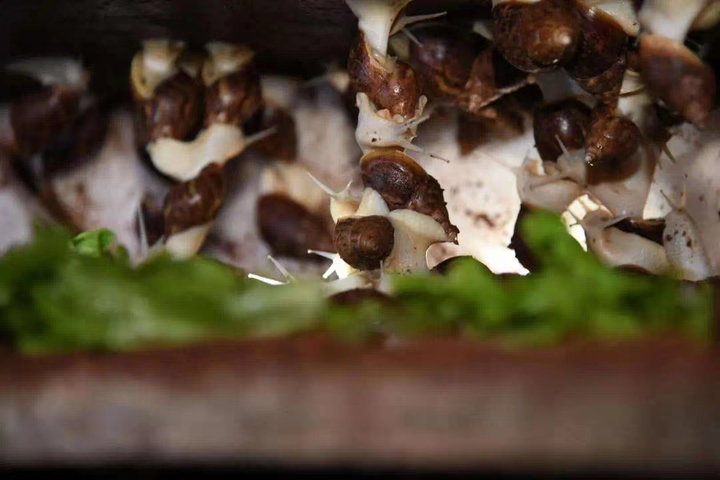
In Shen Fuliang snail breeding base, white jade snails are eating. Image provided by Yuxin Town, Nanhu District.
In China, more than 70% of the live snails started from Shenfuliang snail breeding base in Yuxin Town, Nanhu District, and "climbed" onto the dining tables of high-end hotels and western food chain stores.
“我不是一个人,我背后还有上百户的蜗牛养殖户,大家一起干,才能一起富。”沈福良常常把这句话挂在嘴边。
20年来,他是这么说的,也是这么做的。
常常有外地的考察团问他原因,沈福良就会和他们讲起一个故事。
“真稀奇,省委书记怎么会跑来看蜗牛?”2004年初春,沈福良的基地里围了一圈又一圈父老乡亲,大家纷纷问他省委书记来调研说了啥。
“习书记很关心我们蜗牛产业哩!我跟习书记打了包票:把蜗牛产业做大做强,带动更多农户增收!”沈福良兴奋地说。
沈福良从1999年开始养白玉蜗牛,他脑子活泛,在其他人还在跑市场时,他花5000多元买了台电脑,开启了网上销售。
4年时间,沈福良成了远近闻名的“蜗牛大王”,占据全国市场的一大半。
摊子大了,“蜗牛大王”反而迷茫起来:资源就这么点儿、市场就那么大,还能怎么更进一步?
养蜗牛的人越来越多,大家为了抢订单,已经开始打价格战。
与其大家都亏本赚吆喝,还不如一起赚钱。沈福良与10多个村的100多户农户签订收购协议,以不低于市场价的保护价来收购他们的蜗牛。
At this juncture, the supreme leader comrade came to Qianfu Company to investigate the snail industry. He asked Shen Fuliang with concern about the growth cycle of snails, what they eat, how many farmers the company has driven, product positioning and market prospects … …
Ask carefully, Shen Fuliang also answer seriously.
After bidding farewell to the research team, Shen Fuliang also found several large aquaculture companies to discuss how to do better in the future. He made up his mind secretly: first, to drive more farmers to increase their income and get rich; second, to carry out snail finishing and enhance the added value of products.
In 2005, a news spread like wildfire: Ryan established a rural cooperative organization. Knowing this grassroots innovation, the Supreme Leader conducted in-depth research and strong guidance.
During his work in Zhejiang, the supreme leader comrades not only respected the initiative of the masses, but also learned nutrition from the rich practice of the masses.
In 2006, Zhejiang explored the establishment of a new rural cooperation system of "trinity" of farmers’ professional cooperation, supply and marketing cooperation and credit cooperation.
Establish farmers’ professional cooperatives, so that farmers can share shares and share bigger dividends! Shen Fuliang was deeply inspired. Referring to the operation mode of the new rural cooperative medical system, he explored a set of operation standards, adopted the mode of combining market floating price with protective price, provided farmers with means of production, bought snails, and solved the worries of farmers’ supply and marketing. Later, he also launched the "technical backbone+members+farmers" entrepreneurial assistance mechanism.
Zhejiang, Shanghai, Jiangsu, Shandong, Anhui … … Today, more than 500 farmers in seven provinces and one city follow Shen Fuliang to breed snails, with an average annual income of 100,000 to 300,000 yuan.
In the fields of Zhejiang, there are more and more "Shen Fuliang". In recent years, the ways of increasing farmers’ income and getting rich in Zhejiang are more diversified: farmers’ professional cooperatives, rural cooperative economic organizations federation, agricultural economic development zone … … From scattered "small farmers" to "big farmers", farmers’ "money bags" are becoming more and more bulging.
(5)
On the integration of urban and rural employment and social security from the perspective of seeing a doctor and taking medicine — —
The warmth behind a medical insurance reimbursement window
99.79%。 This is the latest basic medical insurance participation rate of registered population in Wanmin Village, xincheng town, Xiuzhou District in 2024.
Seeing this figure, Xu Zhirong, a staff member of xincheng town Institute of Natural Resources and a rural instructor in Wanmin Village, was relieved. Only after personal experience can he better understand how the medical insurance system has propped up a "sky" for sick villagers.
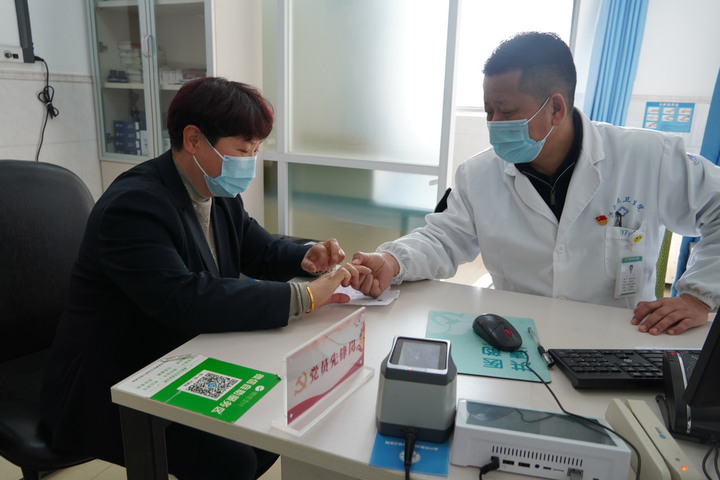
Honghe town health center Image courtesy of Honghe Town.
Xu Zhirong lives in Shi Qiaocun, Thailand, Honghe Town. On the morning of March 26, 2004, he took advantage of his break and rushed to the reimbursement window of rural cooperative medical insurance in the town health center to reimburse medical expenses for his family.
On the same day, the supreme leader comrade came to Honghe town health center for investigation, on the one hand, to check the sanitation situation in the village, on the other hand, to see the farmers’ medical treatment.
After a turn, the Supreme Leader asked the farmers in detail whether it was convenient and expensive to see a doctor.
Xu Zhirong didn’t recognize the identity of the bearer, but he took the message excitedly. His mother-in-law had a tumor operation in Hangzhou at the beginning of the year, and the medical expenses cost more than 20,000 yuan.
More than 20,000 yuan! It can almost cover the income of a family for one year.
Only pay 20 yuan, but fully reimbursed more than 8000 yuan! Xu Zhirong even said "satisfied" three times.
I rushed home and gave the money to my mother-in-law. After watching the news, Xu Zhirong realized that the "leader who was particularly concerned about the lives of ordinary people" was actually the secretary of the provincial party Committee.
After recovering from this serious illness, Xu Zhirong’s mother-in-law has been living healthily in her 80 s.
It is inconvenient to see a doctor, expensive or not, and whether the reimbursement amount is satisfactory or not. These issues that the Supreme Leader comrades were concerned about during the investigation have been lingering in the mind of Shen Qin, then deputy director of Jiaxing Municipal Health Bureau.
At that time, the new rural cooperative medical system was introduced only one year ago, and the villagers’ willingness to participate in insurance was not high, and the government was also anxious.
How to knock on the hearts of villagers? Someone came up with an idea — — Let the people who enjoy the benefits "show their opinions" and let the leaders "go into battle and drink".
In 2004, the leaders in charge of medical insurance in all counties (cities, districts) in Jiaxing received a "task" — — A single reimbursement of more than 10 thousand yuan will be sent to the villagers’ homes by them.
Don’t say, this method really works. The villagers saw the support of the government and the benefits of the policy.
Xu Zhirong is also very busy. As a joint cadre of Liangsan Village at that time, he went door-to-door to help collect cooperative medical care to raise funds, and also told everyone about his experience of reimbursing his mother-in-law.
The painstaking efforts made the people see the good intentions of the government. Someone took the initiative to find Xu Zhirong and sincerely said: "You should participate in medical insurance like paying tuition for your child."
In the past 20 years, government subsidies at all levels in Jiaxing have been increasing. The scale of funds in Jiaxing has been expanded from 10,000 yuan to 3 billion yuan, and the participation rate has remained above 99.5% for many years.
If we say that the urban and rural social security system in Zhejiang Province was still a "small boat" 20 years ago, now, the "small boat" has developed into a "super ship" with wider coverage, higher level and more peace of mind and warmth for the people.
Every Tuesday, Wang An, deputy director of the Department of Rehabilitation of Longyou County People’s Hospital, will visit the Sunshine Community Health Service Station of Longzhou Street Community Health Service Center. "It’s really convenient to see a doctor now. There are not only clinics in the village, but also health centers in the town. Experts from major hospitals in provinces, cities and counties often go to the countryside for free clinics." The villagers at the scene lamented.
In 2009, Longyou became the first batch of medical reform pilot counties in the province, and comprehensively started the reform of the medical and health system; In 2015, it also established assistance and cooperation with provincial top-three hospitals to promote the "double sinking" of quality medical resources. In recent years, in combination with the characteristics of mountainous counties, Longyou has built a "five-level linkage of provinces, cities, counties and villages" medical security system, comprehensively coordinating medical insurance, medicine, hospitals and doctors, improving the ability of primary medical services, and facilitating the people to see a doctor nearby.
(6)
On the integration of urban and rural social development from the perspective of reading problems — —
A bright "cultural light" lit by a library
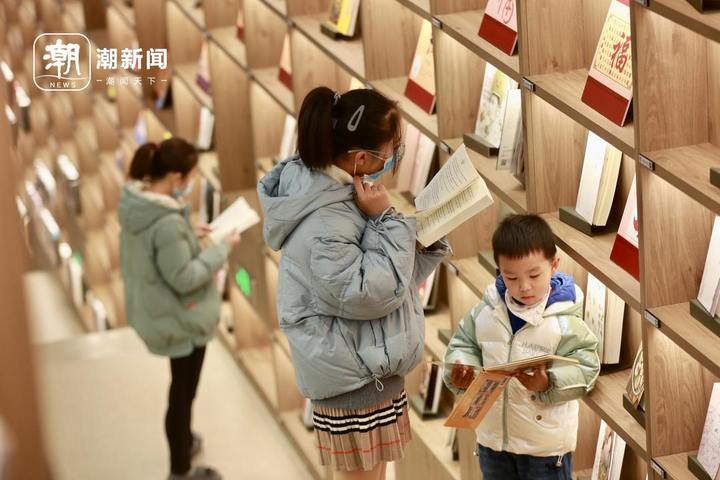
Jiaxing xiuzhou district library. Reporter Wang Zhijie photo
In Jiaxing at night, there is always a lamp that is bright all night, waiting for night readers. This lamp comes from large and small libraries, scattered in downtown streets, towns and villages.
Today’s Jiaxing Library is the national "online celebrity". Every year, 4 million people visit the library, hold 5,000 reader activities, and an average of 30,000 people own a library … …
How is the super popularity tempered? In the view of curator Shen Hongmei, this is inseparable from this survey 20 years ago.
The reporter clearly remembers that during the tight schedule at that time, the research team specially investigated in Jiaxing Library for nearly half an hour, and the most concerned thing was how to promote the integrated development of urban and rural spiritual civilization construction.
Comrade Supreme Leader once said on many occasions: "For many years, we have been troubled by such an annoyance as the low level of economic development. Now that the economy has developed and the problem of food and clothing has been gradually solved, the spiritual and cultural needs of ordinary people will show explosive growth, which will lead to many troubles. Solving these problems mainly depends on culture. "
"Can you transport the high-quality resources of the city library to towns and villages?" After the investigation, Cui Quansen, then director of Jiaxing Library, started a research project — — Integrate the resources of urban and rural libraries, and the cooperation between urban libraries and towns and villages will make people pay for technology!
In 2005, the provincial party committee took speeding up the construction of a cultural province and strengthening the soft power that constitutes Zhejiang’s comprehensive competitiveness as a key task, and the supreme leader personally presided over the research topic.
In July of the same year, the Provincial Party Committee made the "Decision on Accelerating the Construction of a Cultural Province", and comprehensively implemented the "eight projects" of cultural construction, such as civilized quality project, cultural quality project, cultural research project, cultural protection project, cultural industry promotion project, cultural communication project and cultural talent project.
Jiaxing has also introduced implementation policies from the municipal level to link resources from all sides to solve the problem of farmers’ difficulty in reading and borrowing books. At the end of 2007, the district, town and city libraries each contributed 100,000 yuan, and Jiaxing’s first township branch library — — Yuxin branch opened.
Nowadays, not only are libraries blooming everywhere in Zhejiang urban and rural areas, but the construction of "15-minute quality cultural life circle" has made the geographical distribution of public cultural venues and public cultural spaces more balanced and reasonable, allowing urban and rural residents to walk out of their homes and reach public cultural venues and public cultural spaces within 15 minutes.
When the spring breeze of urban-rural integration blows, more and more public services are equated between urban and rural areas in Zhejiang.
(7)
On the integration of urban and rural ecological environment and protection from the perspective of water control in water towns — —
A long-standing "clear water defense war"
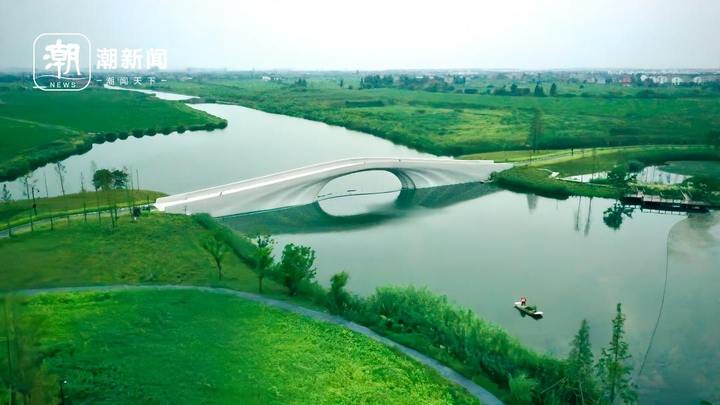
Xiangfudang in the first start-up area of the Yangtze River Delta Ecological Green Integration Development Demonstration Zone. Reporter Wang Zhijie photo
In the early spring evening, the breeze was warm. Zhu Liming, a 48-year-old villager from Donghui Village, Xitang Town, Jiashan County, had a meal and went for a walk in the ecological park beside Xiangfu Dang. In more than 3,400 mu of water, the "underwater forest" has grown up, with clear water and green shores, and fish and birds inhabiting.
Who would have thought that 20 years ago, Donghui Village, which was adjacent to Xiangfudang, was faced with the embarrassment of "no water available in the water town".
Pointed at the pig. Around 2000, more than a dozen villagers in Donghui Village, such as Zhu Liming, began to raise pigs. Rich in pockets, but the pig manure discharged for years is also distressing. The river turns black and stinks, and fish and shrimp have disappeared.
This was also a common problem in many places at that time. At the beginning of the new century, with the rapid economic growth, water shortage and pollution have become a major obstacle on the road to modernization.
The water environment has reached the time when we must pay attention to it! At the turn of May and June, 2003, the Supreme Leader led a team to climb the seawall embankment, check rivers and lakes and streams, and plan for water in five cities including Jiaxing in three days.
Less than a year later, in this special survey in Jiaxing, water environment management is also one of the research contents. The reporter deeply felt that the Supreme Leader attached importance to the urban and rural ecological environment.
After tasting the astringent fruit brought by pollution, people’s mood is even more urgent, and they are determined to restore the coolness and sweetness of that clear water.
Around the construction of an ecological province, the Supreme Leader led the province to carry out a series of major ecological protection and environmental improvement actions in a concentrated and lasting manner, and implemented projects such as "Clear Water River in Wan Li", "Green Passage in Wan Li" and "Ecological Home Enrichment Plan".
Later, the Supreme Leader also regarded Jiashan as the contact point for in-depth study and practice of Scientific Outlook on Development activities. He visited Jiashan for four times and gave instructions on Jiashan’s work for 12 times.
In November 2019, Jiashan, together with Qingpu in Shanghai and Wujiang in Jiangsu, was included in the Yangtze River Delta Ecological Green Integration Development Demonstration Zone. Xiangfudang, located in the pioneering start-up area of the Yangtze River Delta Ecological Green Integration Development Demonstration Zone, together with Jiashan, bears the new mission entrusted by the times.
Later, Jiashan invested 198 million yuan to carry out water ecological restoration projects and landscape improvement projects for the chaotic Xiangfudang water system.
The lake is still the same lake, and now the water quality has reached Class II water standard, and the biodiversity around it has increased by 30%.
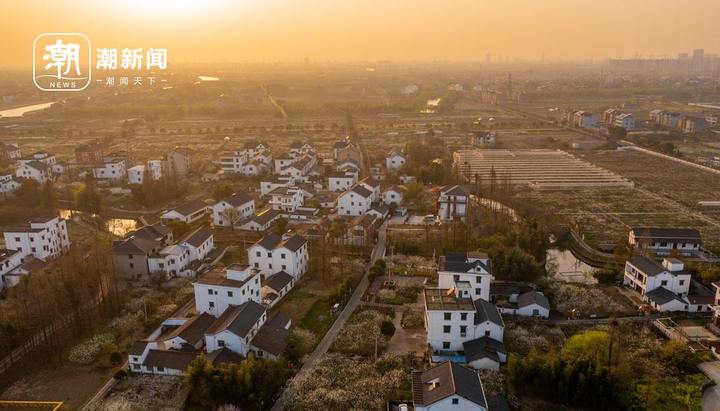
Baquan Village, Heshan Town, Tongxiang City. Reporter Wang Zhijie photo
The boundary between the city and the village has also blurred. On the banks of the lake and beside the village, a 120-square-kilometer Xiangfudang Kechuang Green Valley is rising. A number of high-end research institutes in the Yangtze River Delta have settled in one after another, and more than 500 researchers have been stationed here for a long time, and a large number of cutting-edge high-end projects have sprouted and grown here.
Start with ecology, but not just ecology. Zhejiang has persistently promoted the construction of an ecological province, built the first ecological province in China, and achieved a historic leap in urban and rural landscape.
From 2004 to 2024, spring goes back. Taking the province as a unit, Zhejiang took the lead in solving the dual structure problem of urban and rural regional development and constantly painted a vivid picture of balanced urban and rural development. City and countryside, like lotus, have two flowers, each with its own fragrance.
Standing on this solid foundation, coordinating urban and rural development has been given more and fuller expectations. In May 2021, the CPC Central Committee and the State Council issued the Opinions on Supporting Zhejiang’s High-quality Development and Construction of a Demonstration Zone for Common Prosperity, which entrusted Zhejiang with the heavy responsibility of providing a provincial model for promoting common prosperity throughout the country.
At the beginning of the mountain, the road is ahead. On the land of Zhijiang, the life of urban and rural people will continue to spark more brightly in generate under this baton.
The spring breeze is over, and the harvest is good.
(Chao journalist Zhou Yunan, Shen Yuting, Wang Yuhong, Li Rong, Gu Yuting, China Blue journalist Jiang Zhouyi, Zhao Wei, Rao Siwei, Wang Wenbing, Jiaxing Taiwan Lishui Taiwan Longquan Taiwan Longyoutai)
关于作者